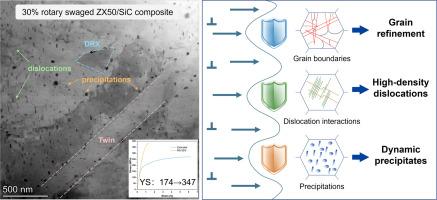Effect of rotary swaging on the microstructure and mechanical properties of Mg-Zn-Ca/SiCp composites
IF 13.8
1区 材料科学
Q1 METALLURGY & METALLURGICAL ENGINEERING
引用次数: 0
Abstract
Due to the poor plasticity and deformability, magnesium matrix composites are difficult to strengthen using traditional severe plastic deformation (SPD) processes. In this study, we applied a large deformation of 0.36 to SiC particles reinforced Mg-Zn-Ca (ZX50/SiCp) composites at room temperature via rotary swaging (RS). The RS process significantly increased the yield strength of the composite from 174.1 MPa after extrusion to 346.5 MPa after RS with ten passes, representing a 98% enhancement. The remarkable strengthening effect was primarily attributed to grain boundaries strengthening, dislocation strengthening and precipitation strengthening effects. The results indicated that the average grain size of the composite refined to 16 µm after ten passes, and a substantial number of deformation twins were developed in the host grains. The interactions between twin boundaries and precipitates as well as reinforcement particles blocked the twin growth, resulting in dense twin networks. With increasing strain, multiple twins developed to further refine the twin lamella. Furthermore, the activation of numerous dislocations developed dislocation arrays and the geometrically necessary dislocations (GNDs) density increased from 2.8 × 10¹⁴ to 7.2 × 10¹⁴ m⁻². In addition, dynamic precipitation occurred during the RS process, resulting in the formation of substantial nano-scale Mg-Zn second phases (average diameter ∼70 nm). The severe shear strain during the RS process promoted the uniformly dispersion of reinforcement particles. These findings provide valuable insights into the fabrication and strengthening of magnesium matrix composites through the proposed RS process.

旋转挤压对Mg-Zn-Ca/SiCp复合材料显微组织和力学性能的影响
由于镁基复合材料的塑性和变形能力较差,传统的强塑性变形(SPD)工艺难以对其进行强化。在本研究中,我们通过旋转锻压(RS)对SiC颗粒增强Mg-Zn-Ca (ZX50/SiCp)复合材料在室温下施加0.36的大变形。经10道次挤压后,复合材料的屈服强度由挤压后的174.1 MPa提高到挤压后的346.5 MPa,提高了98%。强化效果显著的主要原因是晶界强化、位错强化和析出强化效应。结果表明:经过10道次后,复合材料的平均晶粒尺寸细化到16µm,主晶中出现了大量的变形孪晶;孪晶界与析出相以及强化颗粒之间的相互作用阻碍了孪晶的生长,形成致密的孪晶网络。随着应变的增加,孪晶进一步细化孪晶片层。此外,许多位错的激活形成了位错阵列,几何上必要的位错(GNDs)密度从2.8 × 10¹⁴增加到7.2 × 10¹⁴。此外,RS过程中发生了动态沉淀,导致大量纳米级Mg-Zn第二相(平均直径~ 70 nm)的形成。RS过程中较大的剪切应变促进了增强颗粒的均匀分散。这些发现为通过提出的RS工艺制备和强化镁基复合材料提供了有价值的见解。
本文章由计算机程序翻译,如有差异,请以英文原文为准。
求助全文
约1分钟内获得全文
求助全文
来源期刊

Journal of Magnesium and Alloys
Engineering-Mechanics of Materials
CiteScore
20.20
自引率
14.80%
发文量
52
审稿时长
59 days
期刊介绍:
The Journal of Magnesium and Alloys serves as a global platform for both theoretical and experimental studies in magnesium science and engineering. It welcomes submissions investigating various scientific and engineering factors impacting the metallurgy, processing, microstructure, properties, and applications of magnesium and alloys. The journal covers all aspects of magnesium and alloy research, including raw materials, alloy casting, extrusion and deformation, corrosion and surface treatment, joining and machining, simulation and modeling, microstructure evolution and mechanical properties, new alloy development, magnesium-based composites, bio-materials and energy materials, applications, and recycling.
 求助内容:
求助内容: 应助结果提醒方式:
应助结果提醒方式:


